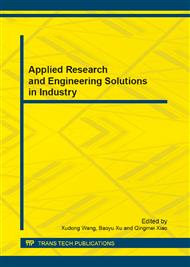[1]
Singh S P, Singh Z (2009) Swinny E E. Postharvest nitric oxide fumigation delays fruit ripening and alleviates chilling injury during cold storage, Japanese plums (Prunus salicina Lindell) 14(4):45-49
DOI: 10.1016/j.postharvbio.2009.04.007
Google Scholar
[2]
Li Dong, Lurie Susan, Zhou Hong-wei (2002) Effect of 1-methylcyclopropene on ripening of "Canino" apricots and "Royal Zee" plums. Postharvest Biology and Technology 25(5):68-72
DOI: 10.1016/s0925-5214(01)00130-2
Google Scholar
[3]
Zhou C H,Xu C J,Sun C D,Li X,Chen (2007) K S.Carotenoids in white-and red-fleshed loquat fruits.Journal of Agriculture and Food Chemistry 55(19):7822-7830
DOI: 10.1021/jf071273h
Google Scholar
[4]
CHEN Jun-wei, FENG Jian-jun, QIN Qiao-ping, LIU Xiao-kun, WU Jiang, XIE Ming (2006) Characteristics of sugar metabolism and accu-mulation in GA3 induced parthenocarpic white flesh loquat Ninghai Bai fruit. Acta Horticulturae Sinica 33(3):471-476
Google Scholar
[5]
Nagasawa A, Finer J J (1988) Development of morphogenic suspension cultures of garlic ( Allium sativum L.) Plant Cell, Tissue and Organ Culture 15(6):183-187
DOI: 10.1007/bf00035760
Google Scholar
[6]
Fereol L, Chovelon V, Cause S, et al (2002) Evidence of a somatic embryogenesis process for plant regeneration in garlic ( Allium sativum L) Plant Cell Report 21(11):197-203
DOI: 10.1007/s00299-002-0498-0
Google Scholar
[7]
Passamonti F, Piccioni E, Standardi A, et al (1998) Micro propagation of Chamomile recutita ( L) Rauschert. Acta Horticulture 45(7):303-309
DOI: 10.17660/actahortic.1998.457.38
Google Scholar
[8]
ZENG SJ, CHENG SJ (1996) Tissue culture and rapid propagation of Dendrobium Journal of Chinese Medicinal Materials 16(10):490-491
Google Scholar
[9]
MAI XY, ZHENG P, LIU RW, et al (1997) Effects of different kinds of medium and sunlight on plantlets of Dendrobium nobile, Guangdong Agricuture Science 23( 3):26-27
Google Scholar
[10]
ZHANG Lin-shui, LI Zh-i ming, LI Bo, WU Xia1 (2006) SHANGGUANG Xiao-x ia1, LI Yan-e. Rapid-Propagation Technique System of Rubus Crataeg if oliusthrough Tissues Culture. Jour nal of Shanx i Agricultural Sciences 34(1):32-34
Google Scholar
[11]
Hyndman S E, Hasegawa P M, Bressan R A (1982) Stimulation of root initiation from cultured rose shoots through the use of reduced concentrations of mineral salts. Hort Science 17(1):82-83
DOI: 10.21273/hortsci.17.1.82
Google Scholar
[12]
Skirvin R M, Chu M C (1979) In vitro propagation of "Forever Yours" rose. Hort Science 14(5):608-610
Google Scholar
[13]
Bressan P H, Kim Y J, Hyndman S E, ET a1 (1982) Factors affecting in vitro propagation of rose. J Am Soc hort Sci 107(2):979-990
DOI: 10.21273/jashs.107.6.979
Google Scholar
[14]
Langford P J (1987) Wainwright H. Effect of sucrose concentration on the photosynthetic ability of rose shoots in vitro.Ann Bot 12(60):633-639
DOI: 10.1093/oxfordjournals.aob.a087493
Google Scholar
[15]
CA I L ing, WANG Y -i hong, HUANG Jin-sh,i L IU Ha-i long, CHEN X iao-m ing (2009) Evaluation for the Four Factors Affecting the Formation of Seedling Root of Cinnamomum camphora in Culture. Journal of West China Forestry Science 138(14):99-102
Google Scholar
[16]
M. Confalonieri, A. Balestrazzi, S. Bisoffi, R. Cella (1995) Factors affecting Agrobacterium tumefaciens-mediated transformation in several black poplar clones 15(5):68-70
DOI: 10.1007/bf00039947
Google Scholar
[17]
Jo. Anne, J (1987) Fillatti, James. Sellmer, Brent Mc. Cown, Bruce Haissig, Luca Comai. Agrobacterium mediated transformation and regeneration of Populus 11(8):34-36
DOI: 10.1007/bf00333574
Google Scholar
[18]
Wang Q C,Tang H R,Quan Y,et a1 (1994) Phenol induced browning and establishment of shoot-tip explants of Fuji' apple and Jinhua Pear'cultured in vitro. J Hort Sci 69(5):833-839
DOI: 10.1080/14620316.1994.11516519
Google Scholar
[19]
Prasad N W,Chatmvedi H C (1988) Effect of season of collection explants on micro propagation of chrysanthemum morifolium. BiclP1ant 30(4):20-24
Google Scholar
[20]
Biedermann E C (1987) Factors affecting establishment and development of Magnolia hybrids in vitro. Acta Hort 21(2):625-629
DOI: 10.17660/actahortic.1987.212.104
Google Scholar
[21]
Benitez J L,Forstera K (1997) Hops and hop products, manual of good practice Amsterdam,Netherlands: EBC and Verlag Hans Carl 15(5):38-42
Google Scholar
[22]
KoKM, Lam BYH (2002) Schisandrin B protects against tert-butylhydro peroxide induced cerebral toxicity by enhancing glutathione antioxidant status in mouse brain Molecular and Cellular Biochemistry 23(8):181-186
Google Scholar
[23]
Chiu P Y, Leung H Y, Poon M K,et al (2006) Schisandrin B induced antioxidant responses partly mediated by cytochrome P-4502 Elcatalyzed reaction in mouse liver. Molecular and Cellular Biochemistry 29(3):87-92
DOI: 10.1007/s11010-006-2957-3
Google Scholar
[24]
Khorassani H SM, Maghsoodlou M T, Ebrahimi A, et al (2007) Kinetics and Mechanism of the Reactions between Triphenylphosphine, Dialkyl Acetylenedicarboxilates and a –NH-Acid, Pyrazole, by UV Spectrophotometry. J Solution Chem 36(12):1117-1127
DOI: 10.1007/s10953-007-9173-y
Google Scholar
[25]
Luo J P, Jian J F (1998) Callus Induction and Plant Regeneration from Hypocotyls Explants of the Forage Legume Ast ragalus adsur 2gens. Plant Cell Rep 17(7):567-569
DOI: 10.1007/s002990050443
Google Scholar


